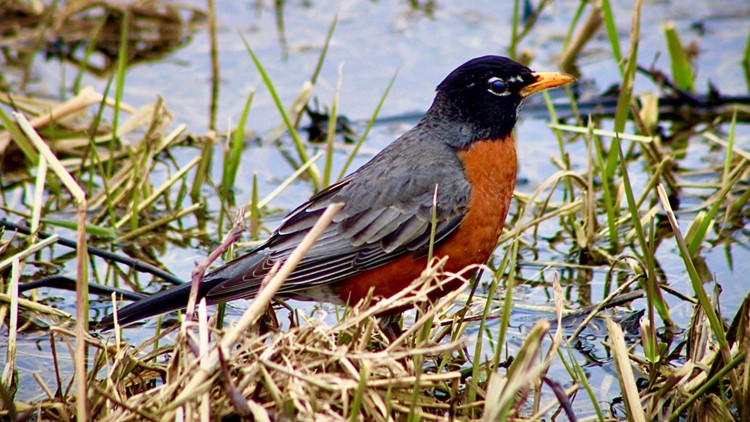GRAND RAPIDS, Mich. — If you sit outside sipping your morning coffee in the spring, it's very likely that sooner or later you'll be joined by an American Robin searching for breakfast in the form of worms. Your yard serves as a potential all-you-can-eat buffet for Michigan's state bird.
But as plentiful and familiar as the American Robin is, Michiganders are seeing fewer of them according to data on a newly released tool by the Cornell Lab or Ornithology's Status and Trends Project.
Cornell uses an app called eBird to collect data from birdwatchers all over the world. Anyone who is able to identify birds can use the app to report birds spotted in their backyard or their local park.
"We can take that information and by using basically artificial intelligence methods, big data analysis methods, we can extract information about how bird populations are changing over time," said Tom Auer, a Hancock, Michigan native who serves as a geospatial data scientist for Cornell.
"The new tool lets people explore. In North America, we have almost all the species and you can see how those species are doing. And what’s novel about this, is the detail that’s available. Most existing descriptions of trends of birds are at the state or province level. But we can actually drill down to a 27 by 27-kilometer cell or pixel and describe the trend that’s going on there. It’s a really great tool for monitoring how birds are doing at fine detail."
Being that I am the resident bird nerd at 13 ON YOUR SIDE, I had to try it out. According to the data, American Robin populations are declining in much of Michigan during breeding season. Some parts of our area saw population drops as significant as 20%.
Robins weren't the only population in decline, either. Other common backyard birds like Black-Capped Chickadees, American Goldfinches and Eastern Bluebirds also had declining populations in much of Michigan.
Auer said this data shows that it's not just endangered species that people should be concerned about - common birds are at risk too. He said this particular research does not pinpoint reasons for the decline of each species, but other science has suggested many reasons for declining bird populations.
"A lot of that is likely due to the continued conversion of habitat to urban spaces. There’s a loss of habitat to feed and raise their young. We’re also seeing some species where it looks like it’s a result of climate change. The north edge of their range is growing dramatically. The populations there are increasing, and the southern range is decreasing," Auer said.
Some common species showing population increases in Michigan include the Blue Jay, the Northern Cardinal, the White-Breasted Nuthatch and several woodpecker species.
So why should we care about declining bird populations? Auer said birds tend to be responsive to environmental changes, and their migration trends give us an idea of the bigger picture when it comes to the health of the environment around us.
"They are what we call valuable indicators of what's going on with ecosystems and landscapes, because they're dependent on those places. They need bugs or fruit or seeds to feed their young, to raise chicks, and to migrate between places across the entire hemisphere," Auer said.
"We get a lot of information about not only the health of different ecosystems in different parts of the country, but also what's going on in terms of changing dynamics at much bigger scales. Are birds arriving earlier than they have been? Are they just not appearing in places anymore? Are they declining more dramatically in some places than others?"
If you'd like to help local bird populations in your area, Cornell has released a list of "seven simple actions" people can take to protect birds.
►Make it easy to keep up to date with more stories like this. Download the 13 ON YOUR SIDE app now.
Have a news tip? Email news@13onyourside.com, visit our Facebook page or Twitter. Subscribe to our YouTube channel.
Watch 13 ON YOUR SIDE for free on Roku, Amazon Fire TV Stick, Apple TV and on your phone.



